The Favelas of Brazil: A Vibrant Tapestry of Creativity and Strength
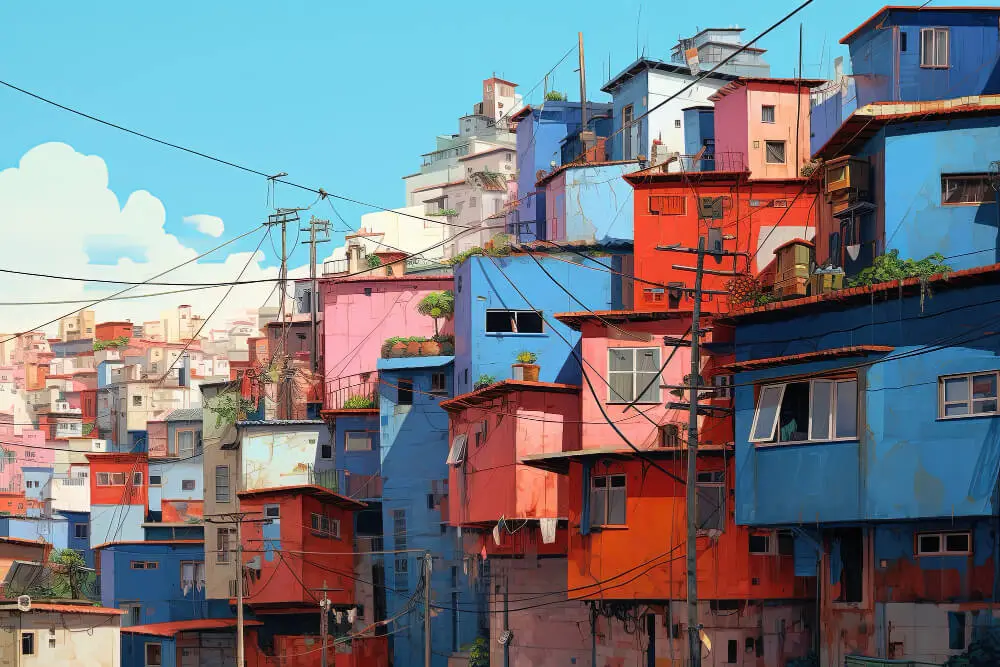
Updated On: March 27, 2024 by Yasmin Elwan
In the vibrant mosaics of Brazil’s urban landscape, favelas stand out as bastions of creativity and resilience. These densely populated neighbourhoods, often characterised by their informal settlements, have given rise to a cultural vivacity that transcends their challenging circumstances. Within the favelas, art and music serve as powerful expressions of community identity and survival, weaving a narrative that is both poignant and triumphant.
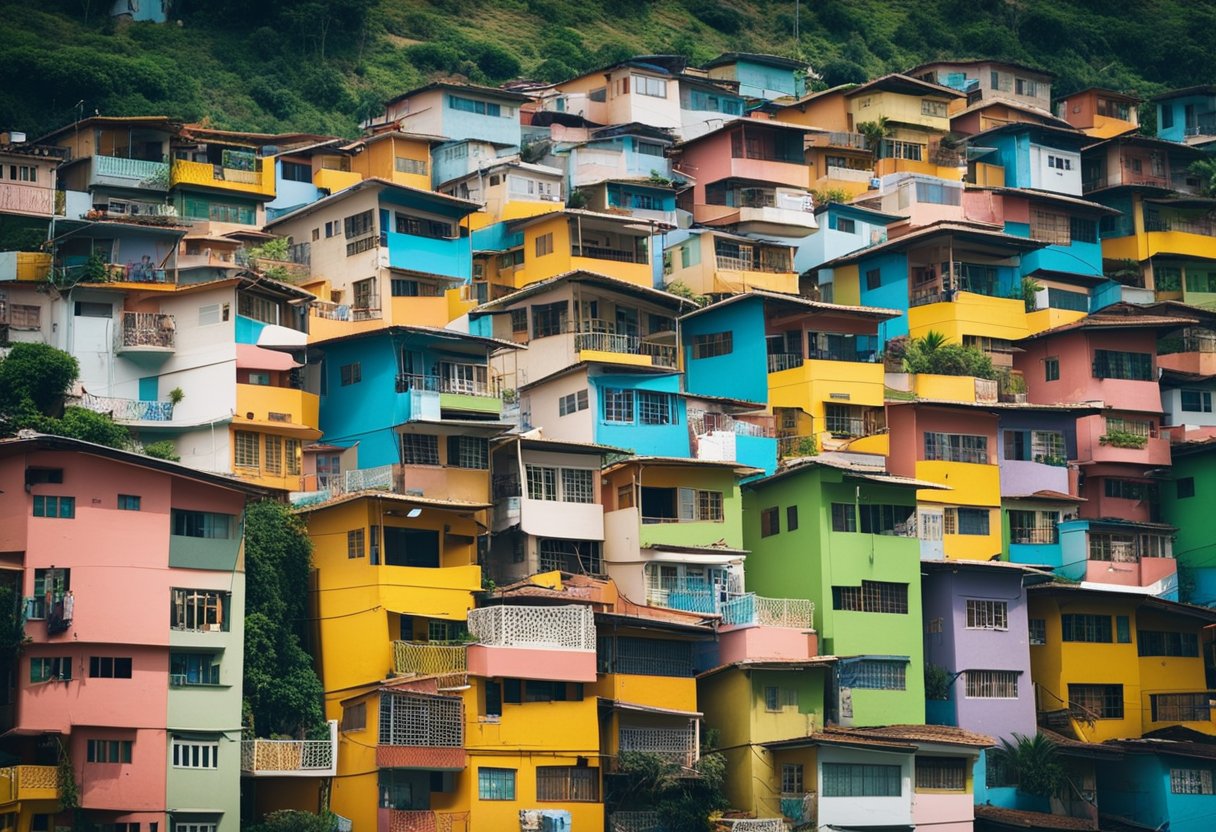
Despite their portrayal in media as areas of deprivation, favelas are indeed crucibles of culture, where residents transform adversity into artistry. From the rhythm of samba that echoes through the narrow alleys to the vivid murals that adorn the walls, the favelas of Brazil are a testament to the unwavering spirit of their inhabitants. This rich cultural fabric is not only a means for the residents to assert their presence but also a channel for social dialogue and cohesion.
Historical Context of Favelas
In this section, we uncover the birth and evolution of favelas, the socioeconomic hurdles they embody, and the varied government responses to these informal settlements.
Origins and Growth
Favelas originated at the end of the 19th century when soldiers without accommodation settled on hills around Rio de Janeiro. Over time, these makeshift communities expanded as migrants seeking opportunities flowed into urban centres like Rio de Janeiro and São Paulo. By erecting informal housing on unoccupied land, often on the peripheries of cities, the population of favelas swelled, underlining the stark contrast between the wealth of urban Brazil and the inequality faced by its poorest citizens.
Socio-Economic Challenges
Living in favelas comes with profound socio-economic challenges. Infrastructure is often lacking, with limited access to clean water, sanitation, and healthcare. Economic opportunities are meagre, and educational facilities, when available, frequently suffer from underfunding. The favelas are also characterised by a history of neglect by city officials, amplifying the struggle for recognition and resources, which perpetuates the cycle of poverty and exclusion.
Government Policies and Interventions
Government responses to these accommodations have fluctuated over the decades. Initially, these communities faced outright neglect, but from the mid-20th century, initiatives like favela eradication and public housing projects aimed to tackle the issue. In recent years, policies have included pacification and police interventions to curb crime. However, such measures often receive criticism for being superficial and failing to address the root causes of the inequality inherent in favelas.
Favelas as Cultural Hubs
In the heart of Brazil’s favelas, a rich tapestry of cultural expressions has emerged, with art and music underpinning the community’s resilient spirit.
The Emergence of Favela Art
Favela art has transformed the image of Brazil’s informal settlements. Once seen as mere symbols of poverty, these communities now illustrate an extraordinary vibrancy through murals and street art. Artists such as JR and Kobra have utilised the very walls of the favelas as canvases, turning neighbourhoods into open-air galleries. This art not only beautifies the area but also tells the personal stories of the residents, reflecting themes of social struggle, identity, and hope.
Music as a Vehicle for Expression
Samba, originating from Afro-Brazilian communities, epitomises the soul of the favelas. It has not just been music but a movement reflecting the hardships and celebrations of life. The percussive beats resonate through the streets, marking a tradition that goes far beyond mere sound – it’s an expression of heritage. Musical collectives provide children with opportunities to learn instruments and engage with their culture, shaping a sense of community and continuity.
Literature and Storytelling
Favelas are also cradles of stories. They have inspired novels, poems, and biographies that articulate the complexities of favela life. Authors from within these communities bring authenticity to their narratives, enriching Brazilian literature with perspectives often overlooked. Their works navigate between the chaotic energy of the favelas and the contemplative moments that reveal the nuanced human experiences within them.
Community Dynamics and Identity
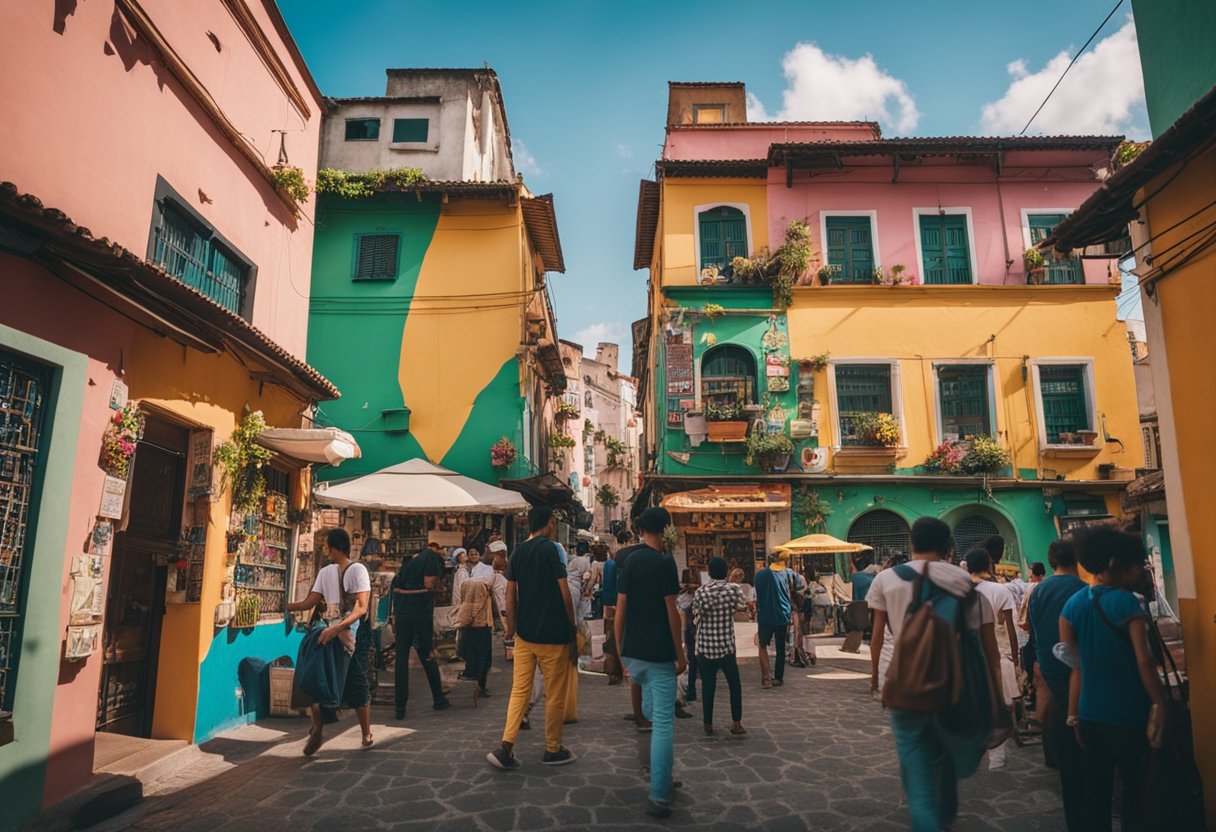
In the favelas of Brazil, the intertwining of community dynamics and identity formation paints a vivid picture of cultural resilience. Here, we take a closer look at how resident solidarity and identity representation forge a powerful narrative within these vibrant communities.
Resident Solidarity
The bond among residents of Brazil’s favelas is the bedrock of their communities. This solidarity is critical for survival, transcending the mere proximity of dense living spaces. In the face of external pressures and socioeconomic challenges, it’s the unyielding spirit of community that fosters mutual aid and shared resilience. Initiatives to improve living conditions, from sanitation to housing, are often community-driven, underpinning a sense of united endeavour.
Identity and Representation
In the realm of identity, the favelas are pulsing with expressions that challenge conventional narratives. The cultural activities—whether it’s graffiti art or the beats of samba—that emanate from the favelas carry a profound significance for resident identity. These expressions are not just acts of artistic creation; they serve as mediums of defiance and representation, cementing a distinct identity within the broader tapestry of Brazilian culture. It’s this rich cultural identity that has, paradoxically, placed those residences at the heart of national identity discussions, illustrating both the limitations and false premises of traditional modernist ideals.
Urban Infrastructure and Quality of Life
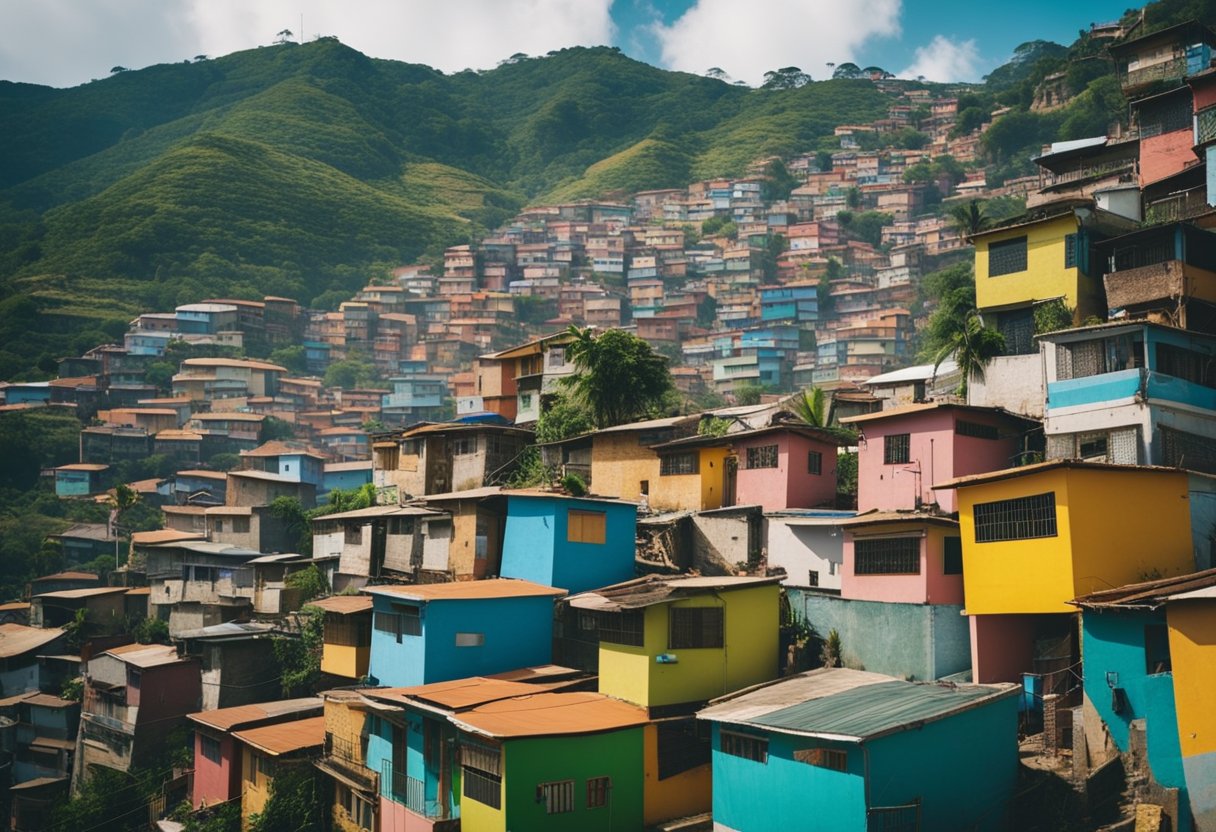
In Brazil’s favelas, the state of urban infrastructure and residents’ quality of life are closely interlinked, affecting everything from housing conditions to public health.
Housing Conditions
Housing within the favelas typically reflects a range of structural challenges, often characterised by overcrowding and unstable constructions. Our understanding is that many residences are built by the inhabitants themselves, using materials that are readily available, which may not always meet construction regulations. This situation impacts not only the safety of the structures but also their resistance to environmental hazards.
Access to Utilities
When discussing water and electricity, we see a disparity in access to utilities in the favelas. Despite improvements, some communities still lack essential services. Water supply can be erratic, and electric connections, often informally established present safety hazards. An assessment of the Favela-Bairro-II (FB2) program found that infrastructure in upgraded residences showed conditions similar to non-upgraded areas after a decade.
Public Health Concerns
Public health is a pressing issue, where dense living conditions can exacerbate the spread of disease and complicate access to health services. Limited nutrition and sanitation infrastructure can lead to higher incidences of health problems. Moreover, the prevalence of vectors for diseases like dengue fever poses additional risks, a concern highlighted in the body of research covering urbanisation in Brazil.
Public Policy and Favela Governance
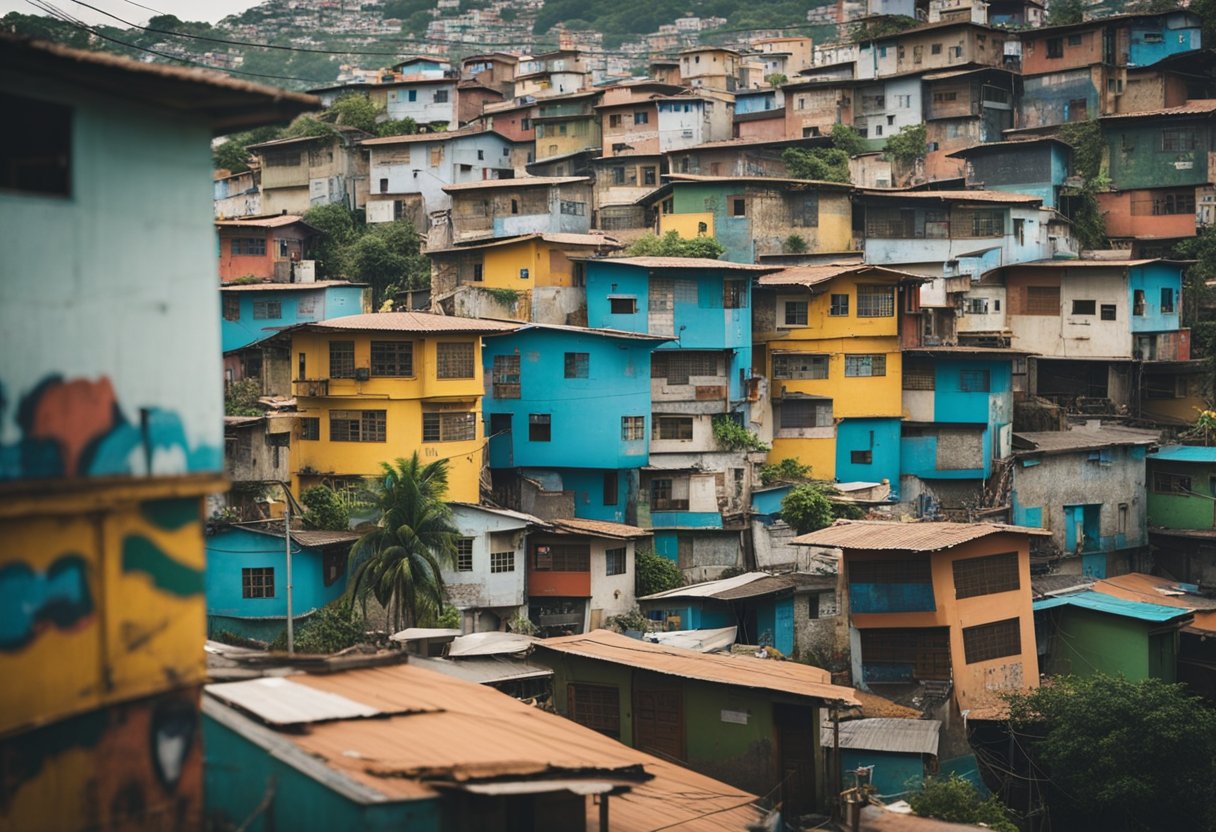
In addressing the complexity of governance in Brazil’s favelas, we must explore the multiple layers of public policy that range from local initiatives to human rights legislation. The dialogue between residents and the government illustrates an ongoing effort to reconcile the needs of these communities with national development strategies.
Local Government Initiatives
Local governments, or prefeituras, have launched various initiatives aimed at improving conditions within the favelas. These involve infrastructure development and community policing efforts, which seek to foster a sense of safety and community. Prominent among such initiatives is the UPP (Pacifying Police Unit), which has had a notable impact on violence and crime rates in several notorious favelas.
Public Housing Projects
The Minha Casa Minha Vida (My House My Life) is a federal public housing program that includes a focus on favela residents. It aims to provide affordable housing to low-income populations, with a view to improving their standard of living and initiating a gradual formalisation of these informal settlements.
Human Rights and Legal Issues
Human rights issues are critical when considering the policies impacting the favelas. Activist groups and NGOs often highlight the need for legal recognition of favela residents’ rights to the city, including their right to adequate housing and public services. Governance in this context becomes a balancing act between upholding human rights and navigating politics and urban development.
Each of these subsections vividly highlights the intricate interplay between Brazilian governance structures at all levels and the unique challenges posed by favela management. Our knowledge of these dynamic frameworks ensures a well-rounded understanding of the endeavours to navigate the political and social landscape of Brazil’s urban settlements.
Social Challenges and Resistance
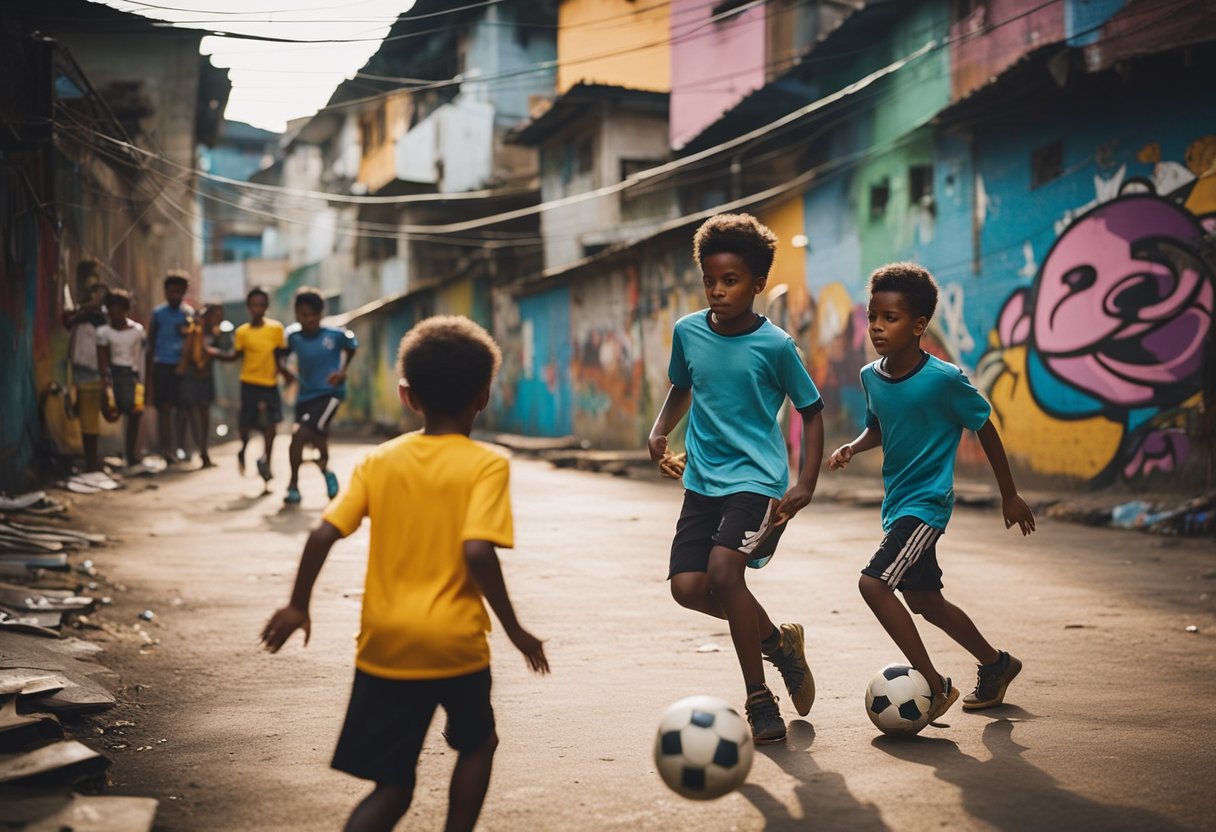
In the favelas of Brazil, the community faces a stark contrast of vibrant culture amidst tough social challenges. Through the persistent adversities of crime and drug trafficking, residents cope with an intense police presence and often find solace in the strength of grassroots organisations.
Crime and Drug Trafficking
Crime and drug trafficking are prominent issues within Brazilian favelas, where the absence of state support can create a vacuum often filled by gangs. The illicit drug trade necessitates a survival strategy for many youths, sometimes caught in the crossfire of territorial disputes. Anderson Sa, a former gang member, is one of the individuals who transformed his challenging experiences in the favelas into activism, promoting peace and resisting the cycle of violence.
Police Presence and Repression
The response to crime in the favelas frequently manifests as heavy-handed police action. Police repression is a harsh reality, with residents often caught between the violence of gangs and the force used by law enforcement. This creates an atmosphere of fear and distrust that overshadows daily life, as arbitrary raids and shoot-outs become part of the favelas’ fabric.
Grassroots Organisations
Despite these oppressive conditions, grassroots organisations thrive, embodying the resilience and agency of the favela communities. They leverage the arts and sports as tools for personal and social transformation, building self-confidence, and fostering community unity. The rich culture of the favelas, including the birth of Samba, demonstrates their role in supporting resistance and challenging the stigma associated with favela life.
Economic Aspects and Opportunities
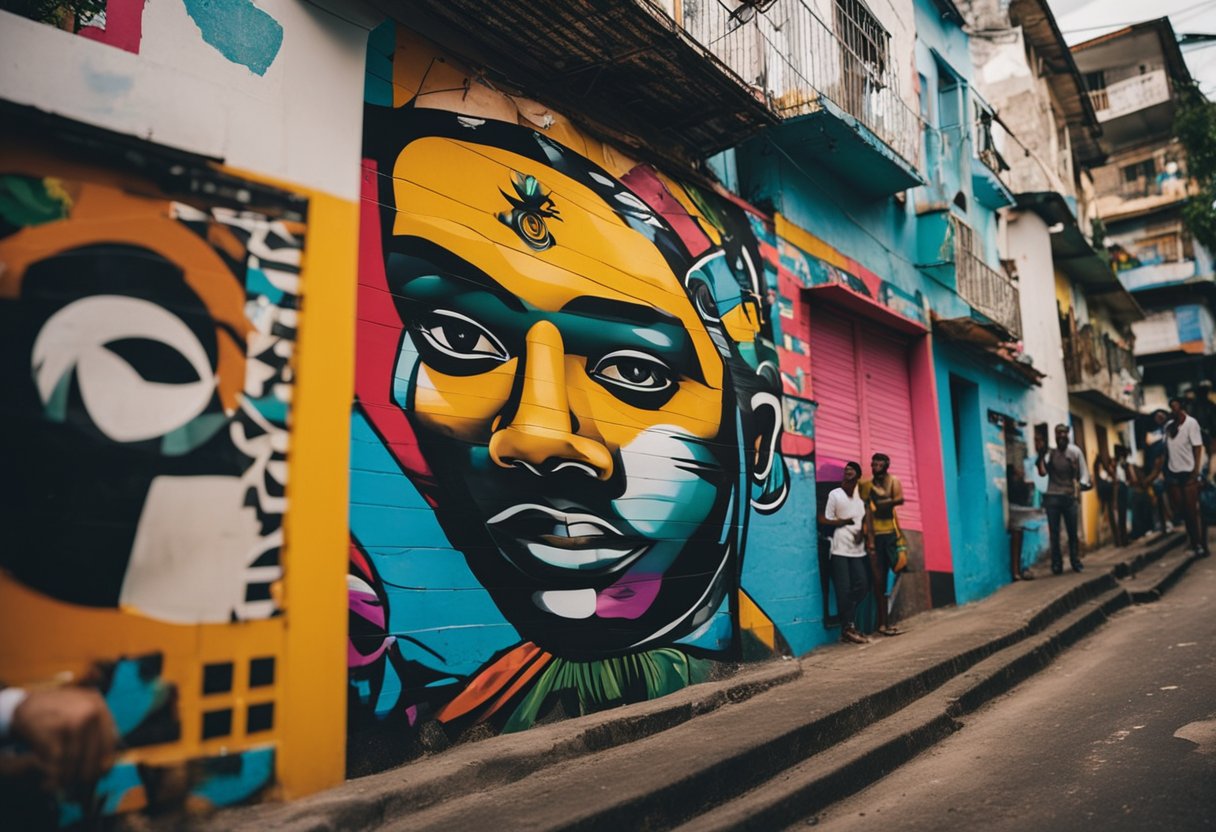
In Brazil’s favelas, economic activity intertwines with resilience as residents navigate between the struggles of poverty and the dynamics of informal employment and entrepreneurship. Here, we shine a light on the dualistic nature of the favela economy, where a lack of formal opportunities coexists with innovative business ventures.
Labour and Employment
In the favelas, the labour market is largely characterised by informal employment. Traditional forms of employment may be scarce, causing many residents to channel their efforts into multiple jobs to sustain their livelihoods. The high rate of unemployment challenges the community, yet the people demonstrate remarkable resilience in creating work for themselves through imaginative means.
Entrepreneurship in the Favelas
Entrepreneurship soars within the favelas, with many residents establishing micro-businesses to overcome economic barriers. Creativity and innovation lie at the heart of these endeavours, often turning social and cultural assets into economic opportunities. These micro-enterprises not only serve to provide income but also to brighten the cultural fabric of the favelas and carry the potential to alleviate local poverty.
Effects of Global Issues on Favelas
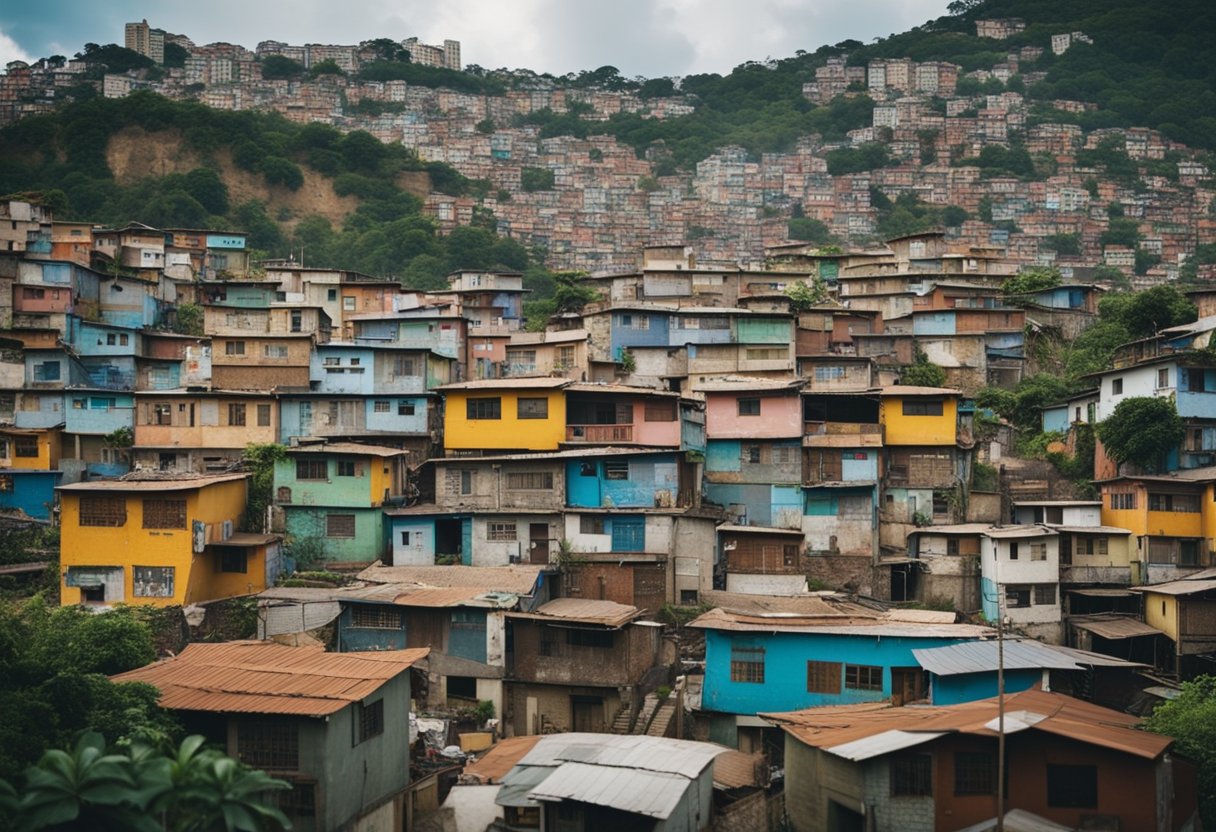
As we delve deeper into the favelas’ global interactions, it’s vital to acknowledge the nuanced ways in which international phenomena such as pandemics and migration patterns reverberate through their intricate social fabric.
Impact of the COVID-19 Pandemic
The COVID-19 pandemic has underscored the disparities faced by communities in the Global South, especially within Brazil’s favelas. Due to overcrowding and limited access to healthcare, these neighbourhoods became highly vulnerable to outbreaks. The resilience of favela dwellers, however, was highlighted through community-driven initiatives that sought to mitigate the impacts, from grassroots education campaigns to local fabrication of PPE when shortages were widespread.
Prevalence and Response
- Number of cases: High relative to national averages
- Community initiatives: Strong, e.g., local health campaigns and PPE production
Migration and Globalisation
Migration into the favelas is both a result and a reflection of globalisation, as individuals relocate in search of better opportunities amidst the challenges posed by global economic shifts. This influx has brought an array of cultural influences that have enriched favela communities, leading to vibrant expressions of art and music. Yet, it also places additional strain on already limited resources and infrastructure.
Cultural Impact
- Enrichment: Diverse influences integrating into favela culture
- Strains: Increased demand on resources and infrastructure
Resilience and Future Perspectives
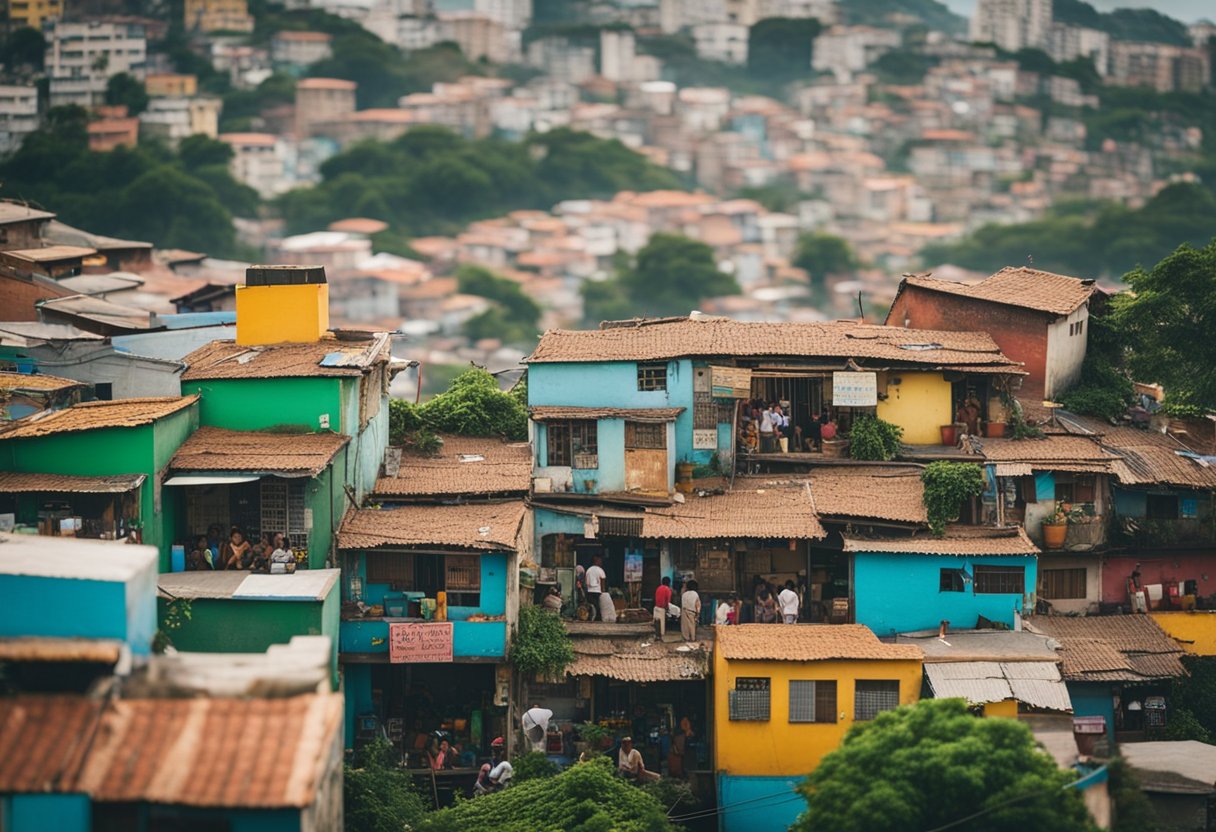
In the vibrant tapestry of Brazil’s favelas, resilience is the thread that weaves together past triumphs and future aspirations. Our examination focuses on the indomitable spirit of the communities and the routes they are charting towards sustainable development.
Overcoming Adversity
Favelas in Brazil are emblematic of both hardship and endurance. Rooted in a history of socio-economic struggle, these communities have often redefined resilience. Through our collective creative expression in art and music, we have forged identities that stand in defiance of marginalisation. In recent years, with the COVID-19 pandemic acting as a stern test, informal governance and collective action in favelas, especially those in São Paulo and Rio de Janeiro, have exemplified adaptability and agility in crisis management.
Visions for Sustainable Development
Looking towards the future, sustainable development is our focal point. Adopting practices that consider the well-being of our environment and community, we strive for growth that does not merely rise from necessity but flourishes into well-planned progress. Initiatives to merge resilience with sustainability are beginning to redefine the development narrative in our favelas. It is in fostering local talents, whether through athletic prowess or cultural ventures that we see a vision forming—one that promotes economic empowerment without compromising our cultural heritage.
Comparative Analysis
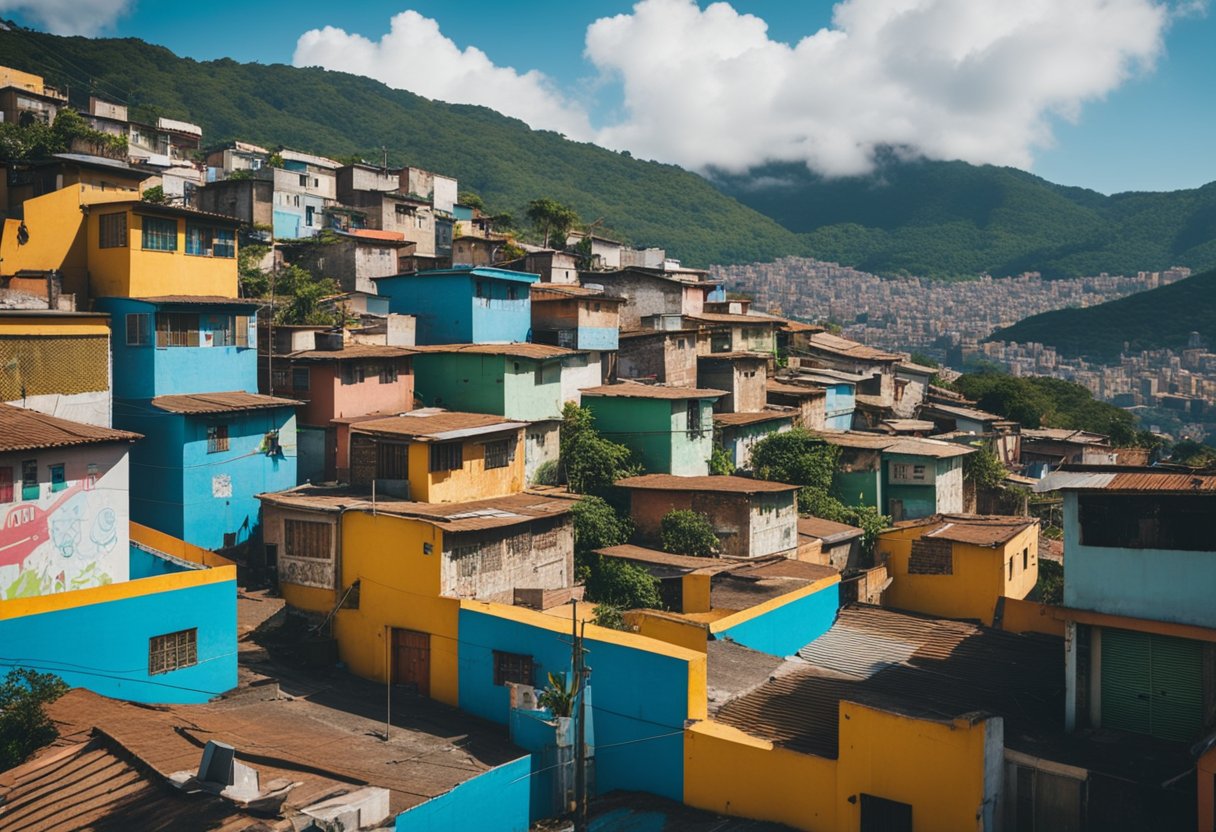
In this section, we will examine how Brazil’s favelas compare to other slums worldwide and their standing in an international context.
Favelas Versus Other Global Slums
Brazilian favelas, much like other slums in regions like Latin America and Europe, are often characterised by high-density living and informal housing structures. However, favelas distinguish themselves through resilience and cultural vibrancy, a trait highlighted by the Documenting Stories of Resilience: Ballet in Brazil’s Favelas. While slums in Europe might be steeped in history, Brazilian favelas have become cultural spheres essential to the national identity, as the cultural sphere essential to Brazilian national identity points out. Unlike European slums, which may have a more transient nature, favelas are often the permanent homes of their residents.
Brazilian Favelas in the International Context
On a global scale, favelas stand as a stark symbol of inequality, much like slums in many parts of the world. Internationally, they’re recognised for their resilient communities despite facing systemic challenges, including violence and forced displacement, as noted in the study on violence and commodification and chronopolitics of disaster.
Comparatively, Brazilian favelas have also garnered international attention through their unique art forms and music, with some artists resisting commodification, as Artists of Brazil’s Favelas Resist Commodification discusses. This resistance and culture of creativity often set them apart from slums in other parts of the world where creative expression may not be as pronounced or recognised.
Frequently Asked Questions
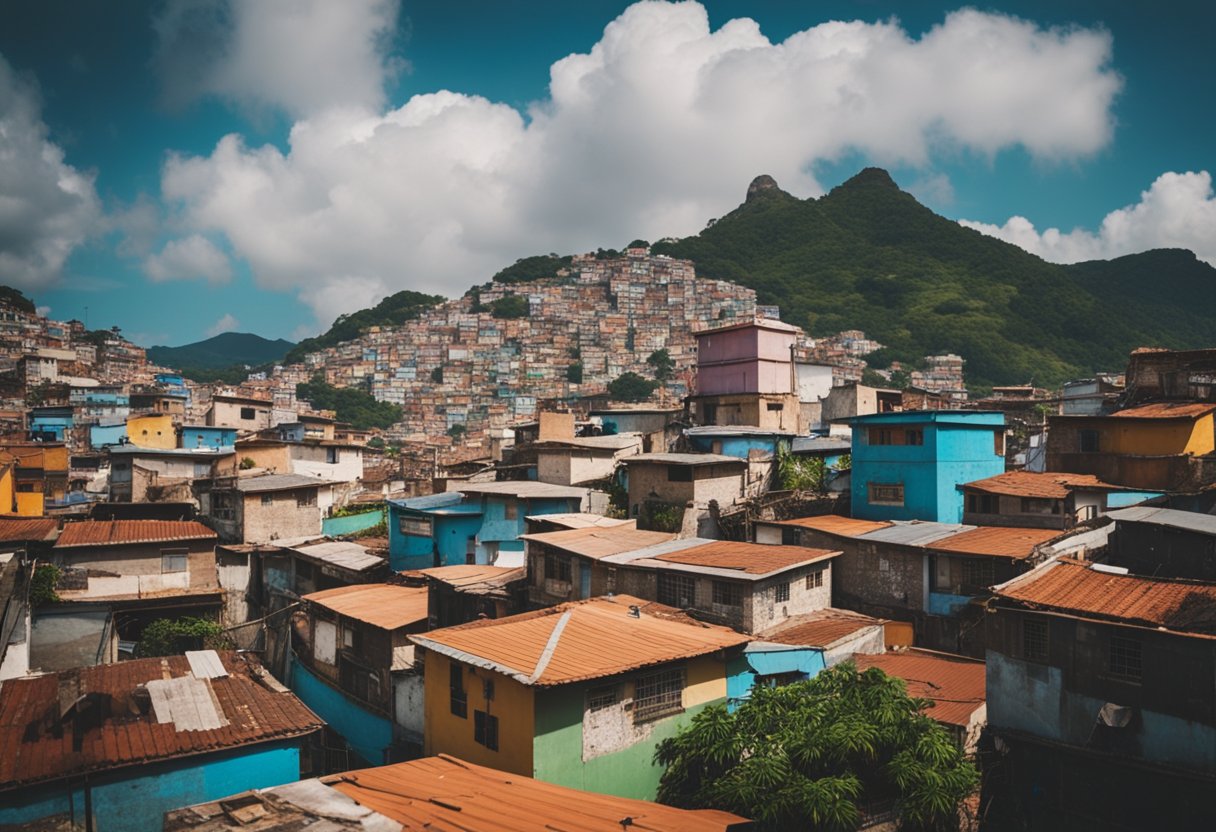
As we explore the favelas of Brazil, frequently asked questions arise about the daily realities, the power of artistic expression, and the resilience of these communities.
What is the nature of daily life within Brazil’s favelas?
Daily life in Brazil’s favelas is marked by a strong sense of community amidst challenging living conditions. These dense neighbourhoods often face issues such as limited access to essential services, but they are also spaces where resourcefulness and solidarity are highly evident.
How do the arts reflect the lived experiences of favela residents?
The arts in the favelas are a vivid mirror of residents’ experiences, capturing the vibrant energy, struggles, and dreams of those who call these communities home. Documenting Stories of Resilience: Ballet in Brazil’s Favelas reveals a narrative of endurance and creative expression through dance.
In what ways does music contribute to the cultural identity of favela communities?
Music is integral to the cultural identity in favela communities, with genres like Funk Carioca originating within these dynamic environments. It’s not only a source of entertainment but a voice for community narratives and a means of cultural expression that resonates beyond their boundaries.
What challenges are faced by inhabitants of Brazilian favelas?
Inhabitants of Brazilian favelas face a multitude of challenges, from violent crime to inadequate housing and infrastructure. Organisations like “TETO Brasil” are working to improve living conditions, reflecting the broader struggles for basic resources and security.
How has resilience shaped the collective spirit in favela neighbourhoods?
Resilience has reinforced the collective spirit in favela neighbourhoods, fostering an unyielding determination to overcome adversity. This resilience is often channelled into vibrant cultural expressions and a commitment to community solidarity.
What role does public art play in community building within the favelas?
Public art plays a transformative role in the favelas, beautifying the environment and providing residents with a sense of pride in their community. It’s a powerful tool for social cohesion, reflecting and reinforcing the unique identity of the neighbourhoods.






